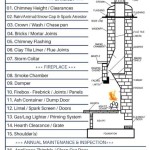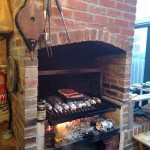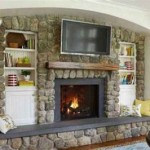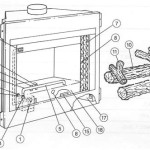Ventless Gas Fireplace Inserts: A Comprehensive Guide
Ventless gas fireplace inserts offer a convenient and relatively straightforward way to add supplemental heat and ambiance to a home. These inserts, also known as vent-free fireplaces, operate without the need for a traditional chimney or venting system, making them attractive options for homeowners seeking a less invasive and often more affordable alternative to conventional fireplaces.
However, the operation and suitability of ventless gas fireplace inserts are subject to specific regulations and considerations. Understanding these aspects is crucial for responsible and safe use.
Key Features and Functionality of Ventless Gas Fireplace Inserts
Ventless gas fireplace inserts operate by burning natural gas or propane with a high level of efficiency. This efficiency is designed to minimize the production of harmful byproducts, such as carbon monoxide. The key to their vent-free operation lies in the inclusion of an Oxygen Depletion Sensor (ODS). This sensor constantly monitors the oxygen levels in the surrounding room. If the oxygen level drops below a pre-determined threshold, indicating a potential buildup of carbon monoxide, the ODS automatically shuts off the gas supply to the unit, preventing further operation.
Most ventless gas fireplace inserts use a blue flame burner system, designed to maximize combustion efficiency. The absence of a chimney or vent means that all the heat generated by the combustion process is released directly into the room, contributing to their heating effectiveness. This results in very high efficiency ratings, often exceeding 99%, which translates to more heat for the fuel consumed. This is in stark contrast to traditional vented fireplaces, where a significant portion of the heat escapes up the chimney.
The inserts are typically housed within a decorative firebox, designed to resemble a traditional fireplace. This firebox can be made from various materials, including cast iron, steel, and ceramic materials. They are available in a range of styles, from traditional to contemporary, to complement different home décor aesthetics. Many models also incorporate realistic-looking artificial logs or decorative elements to enhance the visual appeal and create a more authentic fireplace experience.
Control features vary depending on the model. Some inserts feature simple on/off switches, while others offer more sophisticated programmable thermostats and remote controls. These advanced control options allow for precise temperature regulation and enhanced convenience.
Installation Considerations and Safety Standards
While ventless gas fireplace inserts eliminate the need for a chimney or vent, proper installation and adherence to safety regulations are paramount. Most jurisdictions have specific codes and requirements governing the installation and use of these appliances. Consulting with a qualified professional is essential to ensure compliance with local regulations and safe operation.
Key considerations for installation include ensuring adequate room size. Ventless fireplaces require a minimum room volume to operate safely. This is calculated based on the BTU (British Thermal Units) output of the fireplace. The manufacturer's instructions will specify the minimum room size required. Operating the appliance in a room that is too small can lead to oxygen depletion and the accumulation of harmful byproducts.
Proper ventilation practices are also crucial. While the fireplace itself is vent-free, regular air exchange within the room is necessary to maintain healthy oxygen levels. This can be achieved through periodic opening of windows or doors. The frequency and duration of ventilation will depend on factors such as room size, usage patterns, and the number of occupants.
Installation should be performed by a qualified technician who is experienced in gas appliance installation. This technician will ensure that the gas line connection is properly installed and tested for leaks. They will also verify that the ODS is functioning correctly and that the unit is operating within safe parameters. Regular inspections and maintenance are also recommended to ensure continued safe and efficient operation.
Carbon monoxide detectors should be installed and maintained in the vicinity of the fireplace to provide an additional layer of safety. These detectors will provide an early warning in the event of a carbon monoxide leak. It is crucial to test the detectors regularly and replace the batteries as needed.
Advantages and Disadvantages of Ventless Gas Fireplace Inserts
Ventless gas fireplace inserts offer several advantages. Their primary benefit is the ease of installation and the elimination of the need for a costly chimney or venting system. This makes them a more affordable and less disruptive option compared to traditional fireplaces. They also offer high heating efficiency, as virtually all the heat generated is released into the room. The aesthetic appeal and convenience of operation are also attractive features for many homeowners.
However, there are also potential drawbacks to consider. The requirement for adequate room size and ventilation is a significant limitation. If the room is too small or ventilation is inadequate, the fireplace cannot be operated safely. The potential for carbon monoxide buildup is also a concern, although the ODS is designed to mitigate this risk. Some individuals may be sensitive to the byproducts of combustion, even at low levels. These can include water vapor and nitrogen dioxide, which can potentially trigger respiratory issues in some individuals.
Another potential disadvantage is the odor that can sometimes be associated with ventless gas fireplaces. While modern units are designed to minimize odor, a slight smell may be noticeable, particularly during initial operation or after prolonged use. The perceived aesthetic of the flame and log sets can also be a subjective factor. Some individuals may find that the appearance of a ventless fireplace is not as realistic or visually appealing as a traditional wood-burning or vented gas fireplace.
The regulations and restrictions surrounding ventless gas fireplaces can also be a limiting factor. Some jurisdictions may prohibit their use altogether, or may impose strict requirements for installation and operation. It is essential to research and comply with all applicable regulations before purchasing and installing a ventless gas fireplace insert.
Finally, the long-term maintenance costs associated with ventless fireplaces should be considered. While they are generally reliable, components such as the ODS and burner assembly may require periodic cleaning or replacement. Professional servicing may be necessary to ensure continued safe and efficient operation.

Vent Free Inserts White Mountain Hearth
:max_bytes(150000):strip_icc()/ventless-gas-fireplaces-4160746-hero-f9d4bdcd9bd446eb84406de306f790ba.jpg?strip=all)
How To Pick Out A Ventless Gas Fireplace

What Is A Ventless Gas Fireplace Experts In Gaithersbutg Md

Vent Free Inserts White Mountain Hearth

Small Fireplaces I Hearthcabinet Ventless

Procom 26 000 Btu Vent Free Dual Fuel Propane And Natural Gas Indoor Fireplace Insert With T Stat Control 170082 The Home Depot

Duluth Forge Dual Fuel Ventless Gas Fireplace 32 000 Btu Remote Control Antique White Finish Com

Vent Free Gas Fireplaces Inserts Stoves Napolis Godby Hearth And Home

Gas Fireplaces Inserts And Stoves N Fixin S

Monessen 33 Inch Solstice Vent Free Gas Fireplace Insert Intermittent Pilot








